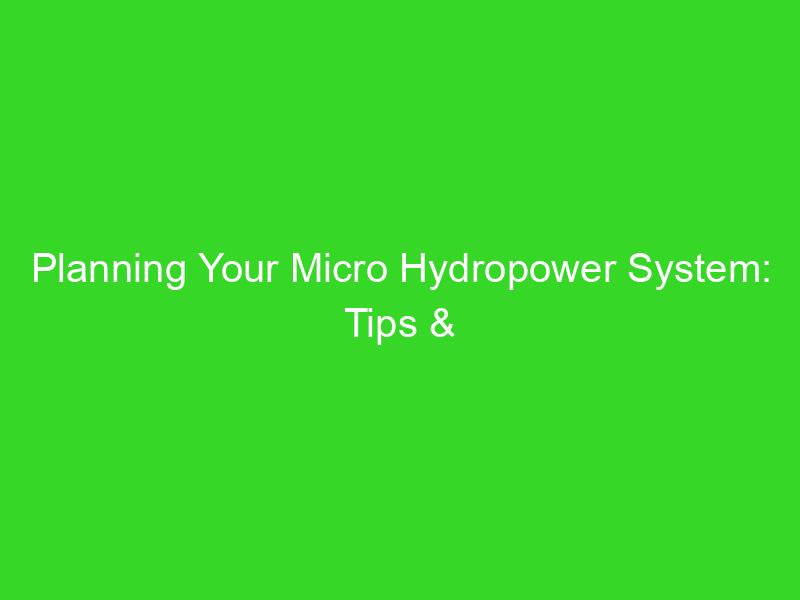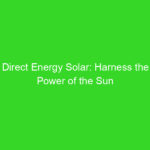
Micro-hydropower is a renewable energy source that has been used for centuries. The earliest form of hydro power generators were water wheels, but today, modern water turbines are used to convert the kinetic energy of moving water into electrical energy. These micro-hydropower systems can range in size from small units generating a few kilowatts of power to larger systems that can generate up to 100kW or more.
Hydroelectric power is highly efficient and can generate power 24/7, making it an ideal source of clean energy for remote communities and off-grid locations. With the increasing demand for sustainable energy sources, micro-hydropower is becoming an increasingly popular choice for power generation.
The key component of any hydro power system is the water turbine generator. Water turbines come in various types and sizes, including Pelton, Francis, and Kaplan turbines. Each type has its own unique characteristics that make it suitable for different applications.
Pelton turbines are best suited for high head applications where there is a large amount of falling water available. Francis turbines are better suited for medium head applications where there is less falling water available but still enough to generate electricity. Kaplan turbines are best suited for low head applications where there is little falling water available but with a high flow rate.
Hydro systems require careful planning and design to ensure maximum efficiency and reliability. Factors such as site selection, flow rate, head height, and turbine selection all play a critical role in determining the overall performance of the system.
Components of a Micro Hydro Power System: Overview, Available Power, and Characteristics
A micro-hydropower system is a renewable energy source that harnesses the power of flowing water to generate electricity. It is an eco-friendly alternative to conventional power sources, as it does not produce any greenhouse gases or other harmful pollutants. A micro-hydropower system consists of several components, including a turbine, generator, control system, and electrical equipment.
Turbine
The turbine is the component that converts the kinetic energy of flowing water into mechanical energy. There are different types of turbines available for use in micro-hydropower systems, including Pelton wheel turbines, Francis turbines, and Cross-flow turbines. The type of turbine used depends on the flow rate and head height of the water source.
Generator
The generator is responsible for converting the mechanical energy produced by the turbine into electrical energy. There are two types of generators used in micro-hydropower systems: synchronous generators and induction generators. Synchronous generators are typically used in high-head systems because they can handle high voltages and frequencies. Induction generators are more commonly used in low-head systems because they require less maintenance.
Control System
The control system regulates the amount of power generated by the micro-hydropower system. It ensures that there is no overloading or underloading of the system by monitoring voltage levels and adjusting output accordingly.
Electrical Equipment
Electrical equipment includes transformers, inverters, batteries, and switchgear. Transformers convert high-voltage electricity from the generator into lower-voltage electricity that can be distributed to homes and businesses. Inverters convert DC (direct current) electricity produced by batteries into AC (alternating current) electricity that can be used to power appliances. Batteries store excess electricity generated by the system for later use when demand exceeds supply.
Available Power
The available power output of a micro-hydropower system depends on the flow rate and head height of the water source, as well as the efficiency of the turbine and generator. The flow rate is the volume of water that passes through a given point in a certain amount of time. The head height is the vertical distance between the water intake and the turbine. A higher flow rate or head height results in more power output.
Efficiency
The efficiency of a micro-hydropower system depends on several factors, including turbine design, generator type, and control system performance. The efficiency can be improved by using high-quality components, optimizing system design, and maintaining equipment regularly.
Types of Micro-Hydropower Systems
Micro-hydropower systems can be classified into two main types: high-head systems and low-head systems. High-head systems are typically used in mountainous regions where there is a significant drop in elevation over a short distance. They require less water flow but have higher pressure, resulting in more power output per unit of water. Low-head systems are used in areas where there is a gradual slope or flat terrain with low elevation differences. They require more water flow but have lower pressure than high-head systems.
Characteristics
High-head systems are characterized by their ability to generate large amounts of power from small amounts of flowing water due to their high pressure. However, they require specialized equipment that can handle high voltages and frequencies. Low-head systems are characterized by their ability to generate power from larger volumes of flowing water at lower pressures. They require less specialized equipment but may need more maintenance due to increased wear and tear.
Design Considerations
When designing and operating a micro-hydropower system, several factors should be taken into account beyond just available power output. Water quality is an important consideration because debris or sediment can damage turbines or clog pipes leading to reduced efficiency or even failure over time if not properly maintained. Environmental impact should also be considered since micro-hydropower systems can affect aquatic habitats and ecosystems. Maintenance requirements should be considered as well, as regular upkeep is necessary to ensure the system operates efficiently for years to come.
Understanding Water Head and Flow in Micro Hydropower Systems
Low head micro hydro systems are becoming increasingly popular due to their ability to generate clean, renewable energy from small streams and low waterfalls. These systems are designed to operate with a water head of less than 10 meters, making them ideal for locations with limited natural resources.
Water head is an essential factor in the design and operation of micro hydropower systems. It refers to the vertical distance between the water intake and the turbine, which determines the amount of potential energy available to generate electricity. The higher the water head, the more potential energy is available.
In low head installations, where waterfalls or drops are minimal, it is essential to maximize every inch of available water head. This can be achieved by using specialized turbines that can efficiently convert even small amounts of potential energy into electricity.
Water flow is equally important in micro hydropower systems as it determines the amount of kinetic energy that can be harnessed by the turbine. The greater the volume of flowing water, the more kinetic energy is available for conversion into electrical power.
Crossflow turbines are commonly used in low head installations due to their ability to efficiently convert both potential and kinetic energy into electricity. These turbines work by directing incoming water through a series of blades that spin a rotor connected to an electrical generator.
The design of crossflow turbines allows them to operate effectively at lower speeds than other types of turbines, making them ideal for use in low head micro hydro systems. They also have fewer moving parts than other types of turbines, reducing maintenance requirements and increasing reliability.
Low head micro hydro systems typically require a minimum flow rate of around 100 liters per second (L/s) for efficient operation. However, this can vary depending on factors such as turbine efficiency and site-specific characteristics such as streambed slope and roughness.
To ensure optimal performance from a low head micro hydro system, it is essential to carefully consider both water head and flow when designing and installing the system. This includes selecting the appropriate turbine type, sizing the system correctly, and ensuring that all components are installed and maintained to a high standard.
In addition to their environmental benefits, low head micro hydro systems can also provide significant economic benefits for rural communities. They offer a reliable source of electricity that is not dependent on fossil fuels or grid infrastructure, reducing energy costs and increasing energy independence.
Measuring Water Flow in Micro Hydropower Sites: Techniques and Tools
Accurate measurement of water flow is crucial in micro hydropower sites to ensure optimal power generation. There are various techniques that can be used to measure water flow in micro hydropower sites, including the use of weirs, flumes, and flow meters. Each technique has its own advantages and disadvantages, and the choice of which one to use depends on several factors such as the size of the site, water speed, and budget.
Weirs are structures placed across the water site that create a known constriction, allowing for the measurement of water flow based on the height of the water level. Weirs can be made from different materials such as concrete or wood and come in different shapes and sizes depending on their purpose. They work by creating a notch or opening through which water flows at a controlled rate. The height of the water level above this notch is then measured using a ruler or staff gauge to determine the volume of water flowing through it.
One advantage of weirs is that they are relatively simple to construct and install compared to other methods. They are also relatively inexpensive compared to other methods such as flumes or flow meters. However, they have some limitations when it comes to measuring high flows since they may overflow if not designed properly.
Flumes are similar to weirs but are more complex and can measure a wider range of water speeds and flows. Flumes work by creating a constriction in the channel where water flows at a known rate. The constriction causes an increase in velocity which can be measured using sensors located upstream and downstream from it. The difference in velocity between these two points is proportional to the flow rate through the flume.
One advantage of flumes over weirs is that they can handle higher flows without overflowing since they have larger openings than weirs. They also provide more accurate measurements since they take into account changes in velocity due to variations in channel geometry.
Flow meters use sensors to measure the speed of the water passing through them, providing real-time data on water flow in micro hydropower sites. There are different types of flow meters such as electromagnetic, ultrasonic, and Doppler which work based on different principles. Electromagnetic flow meters work by measuring the voltage generated when a conductive fluid flows through a magnetic field. Ultrasonic flow meters use sound waves to measure the velocity of the fluid while Doppler flow meters use sound waves reflected off particles in the fluid to determine its velocity.
One advantage of flow meters is that they provide real-time data on water flow which can be used for monitoring and control purposes. They are also more accurate than weirs or flumes since they do not depend on visual observation or manual measurements. However, they are more expensive than other methods and require regular maintenance to ensure accurate readings.
Determining Water Flow Rate in Micro Hydropower Sites: Methods and Formulas
Flow rate is a crucial factor in determining the potential power output of a micro hydropower site, as it directly affects the amount of energy that can be generated. In order to accurately determine water flow rate, it is important to understand how water velocity is used to calculate flow rate. There are various methods for measuring water velocity, including the float method and pitot tube method.
The float method involves releasing a floating object into the water flow and timing how long it takes to travel a set distance. This method can be effective for smaller flows, but may not provide accurate results for larger flows. The pitot tube method involves using a device that measures pressure differences between two points in the water flow. This method can provide more accurate results than the float method, but may require more specialized equipment.
Once water velocity has been measured, it can be used to calculate flow rate using a simple formula: Q = AV, where Q represents flow rate (in cubic meters per second), A represents cross-sectional area (in square meters), and V represents water velocity (in meters per second). It is important to note that this formula assumes uniform flow conditions and neglects friction losses.
Friction losses must also be taken into account when calculating flow rate in micro hydropower sites. Friction losses occur due to resistance from surfaces in contact with the flowing water, such as pipes or channels. These losses can significantly reduce the amount of energy that can be harnessed from the water flow.
There are various methods for accounting for friction losses when calculating flow rate. One common approach is to use Darcy-Weisbach equation: hf = f(L/D)(V^2/2g), where hf represents head loss due to friction (in meters), f represents friction factor (dimensionless), L represents length of pipe or channel (in meters), D represents diameter of pipe or hydraulic radius of channel (in meters), V represents water velocity (in meters per second), and g represents acceleration due to gravity (9.81 m/s^2).
The Darcy-Weisbach equation can be used to calculate the head loss due to friction, which can then be subtracted from the total head available in order to determine the net head available for power generation. This net head can then be used in conjunction with flow rate to calculate potential power output using the formula P = QρgHη, where P represents power output (in watts), Q represents flow rate (in cubic meters per second), ρ represents water density (1000 kg/m^3), g represents acceleration due to gravity (9.81 m/s^2), H represents net head (in meters), and η represents efficiency of turbine-generator system.
It is important to note that while these formulas provide a theoretical basis for calculating potential power output, actual power output may vary depending on various factors such as turbine efficiency, generator efficiency, and transmission losses.
Vertical Head Height in Micro Hydropower Systems: Calculations and Considerations
Calculating the Vertical Head Height in Micro Hydropower Systems: A Comprehensive Guide
The vertical head height is a crucial factor that determines the feasibility of generating power. The head height refers to the vertical distance between the intake and turbine, and it directly affects the amount of power that can be produced. In general, high head systems with a vertical distance of more than 10 meters are more efficient and produce more power than low head systems.
Calculating Head Height: Factors to Consider
While calculating head height may seem straightforward at first glance, there are several factors that need to be considered to ensure accurate measurements and optimal system performance. These factors include friction losses, pipe diameter, and flow rate.
Friction Losses
Friction losses occur when water flows through pipes or other components in a hydropower system. These losses can significantly reduce the amount of power generated by the system if not accounted for during calculations. To minimize friction losses, it's important to choose pipes with a smooth surface finish and an appropriate diameter based on flow rate.
Pipe Diameter
The diameter of pipes used in a hydropower system is also an essential factor when calculating head height. The larger the pipe diameter, the less resistance water will encounter as it flows through the system, resulting in lower friction losses and higher efficiency.
Flow Rate
The flow rate of water through a hydropower system is another critical factor that needs to be considered when calculating head height. Flow rate refers to how much water passes through a specific point over time and is typically measured in liters per second or cubic meters per hour. Accurately measuring flow rate ensures that you have enough information to calculate head height accurately.
Calculating Head Height: An Example
To illustrate how these factors come together when calculating head height let's consider an example:
Suppose we have a micro-hydropower system with an intake located 20 meters above the turbine. The pipe diameter is 10 centimeters, and the flow rate is 50 liters per second. We can use these values to calculate the head height as follows:
- Calculate friction losses: To do this, we need to know the length of the pipe and its roughness coefficient. Suppose our pipe is 100 meters long with a roughness coefficient of 0.02 mm. Using a friction loss calculator or formula, we can determine that friction losses are approximately 2 meters.
- Subtract friction losses from vertical distance: In our example, we have a vertical distance of 20 meters between intake and turbine but lose an additional two meters due to friction losses in the pipes. Therefore, our effective head height is 18 meters.
- Determine power output: Once we have calculated head height, we can use it to determine how much power our system will generate using an appropriate formula or calculator.
Considerations for High Head Systems
High head systems are generally more efficient than low head systems since they produce more power for a given water flow rate due to gravity's increased potential energy at higher elevations. However, there are some considerations when designing high head systems that should be taken into account.
One consideration is that high head systems require specialized turbines designed to handle high water pressure and velocity effectively. These turbines typically have smaller blades and operate at higher speeds than those used in low head systems.
Another consideration is that high head systems may require additional components such as penstocks or surge tanks to regulate water pressure and prevent damage to system components due to sudden changes in flow rate or pressure.
Low Pressure Micro Hydro Schemes: A Viable Option for Small-Scale Energy Production
Low pressure micro hydro schemes are an excellent option for small-scale energy production, especially in areas with low flow rates of water. These micro hydro systems are highly efficient and can generate electricity using a small hydroelectric generator or micro hydro turbine generators. They are a renewable energy source that can provide direct current (DC) electricity generation, making them an ideal choice for off-grid energy systems.
Micro Hydro Power System
A micro hydro power system is a type of renewable energy system that uses the natural flow of water to generate electricity. It works by converting the kinetic energy of moving water into electrical energy using a turbine or generator. The amount of electricity generated depends on the volume and speed of the flowing water.
Microhydro Systems
Microhydro systems are designed to capture the power from falling water and convert it into usable electricity. These systems typically consist of three main components: a turbine, a generator, and control equipment. The turbine is responsible for capturing the kinetic energy from falling water and converting it into rotational motion. This motion is then used to turn the generator, which converts this mechanical energy into electrical energy.
Micro Hydro Generators
A micro hydro generator is a type of generator that is specifically designed to produce electricity from small-scale hydropower systems. These generators come in various sizes and capacities depending on their intended use.
Small Hydroelectric Generator
A small hydroelectric generator is another type of renewable energy source that generates electricity by harnessing the power of flowing water. Unlike large-scale hydropower plants, which require massive dams and reservoirs, small hydroelectric generators can be installed in smaller rivers or streams.
Micro Hydro Turbine Generators
Micro hydro turbine generators are similar to other types of turbines in that they convert kinetic energy into mechanical motion. However, these turbines are specifically designed for use in low-pressure micro-hydro schemes where flow rates are low. They are compact, efficient, and can generate electricity even with a small amount of water flow.
Renewable Energy
Micro hydro systems are a renewable energy source that provides an alternative to fossil fuels. Unlike fossil fuels, which are finite resources that will eventually run out, micro hydro systems rely on the natural flow of water to generate electricity. This means that they have the potential to provide clean and sustainable energy for many years to come.
Low Pressure
Low pressure micro hydro schemes are particularly suited for areas where water flow rates are low. These systems can still generate electricity even with low-pressure flows, making them ideal for small-scale energy production in rural areas or off-grid locations.
Energy Systems
Micro hydro systems can be used as standalone energy systems or as part of a larger renewable energy system. They can be combined with solar panels or wind turbines to create hybrid renewable energy systems that provide reliable and consistent power.
Electricity Generation
Micro hydro systems can generate both AC (alternating current) and DC (direct current) electricity depending on the type of generator used. DC generators are typically used in off-grid applications where batteries store excess power generated during peak times for use later when demand is high.
Generators
There are various types of generators used in micro-hydro schemes, including synchronous generators, asynchronous generators, and permanent magnet generators. Each type has its own advantages and disadvantages depending on the specific application.
Low Flow
Low-flow micro-hydro schemes require specialized equipment designed specifically for low-pressure applications. Suneco Hydro is one company that specializes in designing and manufacturing equipment for low-flow micro-hydro schemes.
Choosing Suitable Locations for DIY Micro Hydropower Systems
Conducting a Thorough Site Assessment for DIY Micro Hydropower Systems
Choosing the right location is crucial. A thorough site assessment is necessary to determine the feasibility of such an installation. Several factors need to be considered when selecting a suitable location for DIY micro-hydropower systems.
Look for Consistent and Reliable Water Sources
The first thing to consider is the availability of water sources in the area. Look for locations with consistent and reliable water sources, such as streams or rivers that can provide enough flow and head to generate electricity. The amount of energy produced by a hydroelectric generator depends on both the volume of water flowing through it and the height from which it falls.
Consider the Size and Type of Hydroelectric Generator Kit
Once you have identified a suitable water source, consider the size and type of hydroelectric generator kit that will be appropriate for your location's energy needs. There are several types of hydroelectric generators available in various sizes, ranging from small turbines that can produce 100 watts to larger ones capable of producing up to 100 kilowatts.
Take into Account Legal or Regulatory Requirements
Before installing any micro-hydropower system, ensure you comply with all legal or regulatory requirements in your area. Some localities require permits or environmental impact assessments before allowing any installations. It is essential to research these requirements beforehand so that you do not encounter any legal issues later on.
Ensure Safety and Meet Electrical Requirements
Safety should always be a top priority when installing any kind of electrical equipment, including micro-hydropower systems. Ensure that all necessary electrical and structural requirements are met before starting installation work. This will prevent accidents or damage to the surrounding environment.
Examples of Suitable Locations for DIY Micro Hydropower Systems
There are several examples where DIY micro-hydropower systems have been successfully installed:
- Small Streams: Small streams with consistent and reliable water flow can be ideal for installing micro-hydropower systems. These systems can produce enough energy to power a small home or cabin.
- Irrigation Canals: Irrigation canals are another excellent location for micro-hydropower installations. They have a consistent and reliable water source, making them perfect for generating electricity.
- Waterfalls: Waterfalls provide an excellent source of energy as they have both the necessary flow and head to generate electricity. However, it is essential to ensure that the waterfall's height is not too high as this can lead to safety concerns.
According to a report by the National Renewable Energy Laboratory (NREL), hydropower has been one of the most significant sources of renewable energy in the United States since 1940. In 2019, hydropower accounted for approximately 7% of total U.S. electricity generation.
In Europe, there has been a significant increase in micro-hydropower installations over recent years due to its environmental benefits and cost-effectiveness. According to Eurostat data, hydropower accounted for 10% of total EU electricity generation in 2018.
The Cost of Micro Hydropower Systems: Measuring Head and Obtaining Permits
Measuring head is crucial for determining the feasibility of a micro-hydropower system. The head refers to the vertical distance between the water source and turbine, which is used to calculate the potential energy that can be harnessed from the water. In addition to measuring head, it's also important to measure the flow rate of water, which determines how much power can be generated by the system.
There are various methods for measuring head, including using a pressure gauge or an electronic sensor. However, these methods can be expensive and require specialized equipment. A simpler method is to use a water level indicator or an altitude gauge, which measures the height of the water surface relative to a fixed point on land.
Once you have measured head and determined that your site has sufficient potential energy to generate electricity, you will need to obtain permits before installing your micro-hydropower system. This includes environmental and construction permits, which can vary depending on your location and regulations.
Environmental permits are required to ensure that your project does not harm local ecosystems or wildlife habitats. This may involve conducting an environmental impact assessment (EIA) or obtaining clearance from local authorities such as the Department of Environment and Natural Resources (DENR).
Construction permits are required to ensure that your project complies with building codes and safety standards. This may involve obtaining clearance from local authorities such as the Building Official or Municipal Engineer.
The cost of obtaining permits can vary widely depending on your location and regulatory requirements. In some cases, permit fees may be waived for small-scale renewable energy projects such as micro-hydropower systems.
In addition to permit costs, it's important to factor in maintenance costs when considering the overall cost of a micro-hydropower system. Regular maintenance is necessary to ensure optimal performance and longevity of the system.
Maintenance tasks may include cleaning debris from intake screens, lubricating bearings and other moving parts, inspecting electrical components for wear or damage, and replacing worn or damaged parts as needed. It's important to schedule regular maintenance tasks to prevent problems before they occur.
Despite the initial costs, micro-hydropower systems can provide long-term cost savings compared to traditional grid-connected electricity, especially in areas with high electricity prices or limited access to grid electricity. In addition to cost savings, micro-hydropower systems offer other benefits such as reduced carbon emissions and increased energy independence.
For example, a study by the International Renewable Energy Agency (IRENA) found that off-grid renewable energy solutions such as micro-hydropower can be more cost-effective than grid extension in rural areas of developing countries. The study found that micro-hydropower systems had an average levelized cost of electricity (LCOE) of $0.08 per kWh, compared to $0.20 per kWh for diesel generators.
Another benefit of micro-hydropower systems is their scalability. They can be designed to meet a wide range of power needs, from small-scale applications such as powering a single home or farm to larger-scale applications such as powering entire communities or industries.
The Benefits and Potential of Micro-Hydropower
In conclusion, micro-hydropower systems offer numerous benefits and potentials for small-scale energy production. With the right components, understanding of water head and flow, measurement techniques, and calculations, anyone can build their own DIY micro hydropower system.
One of the most significant advantages of micro-hydropower is its reliability. Unlike solar or wind power systems that depend on weather conditions, water flow in a stream or river remains relatively constant throughout the year. This consistency makes it an excellent source of renewable energy for off-grid homes, remote communities, and farms.
Moreover, micro-hydropower systems are environmentally friendly as they do not produce greenhouse gases or other pollutants that harm the environment. They also have low maintenance costs compared to other renewable energy sources such as solar panels.
Another benefit of micro-hydropower is its potential to generate income through selling excess electricity back to the grid. Homeowners with a surplus amount of electricity generated from their mini or pico hydro turbine can sell it to their local utility company at a fair price.
Additionally, building a DIY micro hydropower system can be an excellent way to learn new skills while saving money on electricity bills. It is also an opportunity to reduce one's carbon footprint while contributing positively to the environment.
The potential for micro-hydropower extends beyond individual households. Small-scale hydroelectric plants can provide reliable and sustainable energy for entire communities without relying on fossil fuels. These plants can be built in areas where there is enough water flow but no access to the national grid.





